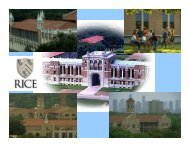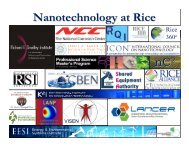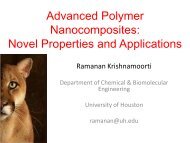Richard E. Smalley Institute for Nanoscale Science and - Center for ...
Richard E. Smalley Institute for Nanoscale Science and - Center for ...
Richard E. Smalley Institute for Nanoscale Science and - Center for ...
You also want an ePaper? Increase the reach of your titles
YUMPU automatically turns print PDFs into web optimized ePapers that Google loves.
Junichiro Kono<br />
Daniel Mittleman<br />
Enrique Barrera<br />
20<br />
Defense<br />
Professor Junichiro Kono investigates<br />
semiconductor nanostructures <strong>and</strong> quantum<br />
device structures to develop hightemperature<br />
infrared sensors. Infrared<br />
sensors are used in thermal imaging.<br />
For high-definition thermal imaging, the<br />
sensors have to be cryogenically cooled.<br />
Kono’s sensor technology increases the<br />
implementation possibilities to include military<br />
vehicles <strong>and</strong> satellites where power<br />
<strong>and</strong> space are minimal.<br />
Kono also discovered a tunable material<br />
that can either transmit or block terahertz<br />
(THz) signals. THz signals are being investigated<br />
<strong>for</strong> use in high-altitude communications<br />
like aircraft to satellite <strong>and</strong> satellite to<br />
satellite as well as security screening <strong>and</strong><br />
surveillance since THz penetrate fabrics<br />
<strong>and</strong> plastics. Kono’s group is developing<br />
similar materials with wider effective-temperature<br />
ranges.<br />
Professor Mittleman’s laboratory focuses<br />
on THz technologies. THz sensing techniques<br />
have been identified as a promising<br />
new technology plat<strong>for</strong>m <strong>for</strong> a variety of<br />
tasks, including environmental monitoring<br />
<strong>and</strong> chemical/biological weapons detection.<br />
Air Force applications requiring the<br />
detection of a single molecule of high<br />
explosive or chemical compound include<br />
improvised explosive device detection;<br />
reconnaissance; <strong>and</strong> chemical, biological<br />
or radiological agent detection <strong>and</strong><br />
identification.<br />
Professor Enrique Barrera’s research group<br />
studies hypervelocity impact properties<br />
of nanocomposites. Hypervelocity, more<br />
than 6,700 mph, can drastically change a<br />
material’s behavior, especially under impact<br />
where metals can behave like fluids.<br />
Nanocomposites are of particular interest<br />
because nanoparticle incorporation<br />
increases the tailorable variables in materials<br />
engineering. Hypervelocity impacts<br />
are of particular interest in systems <strong>and</strong><br />
products like the space shuttle, missiles,<br />
<strong>and</strong> vehicle <strong>and</strong> personal armor.






